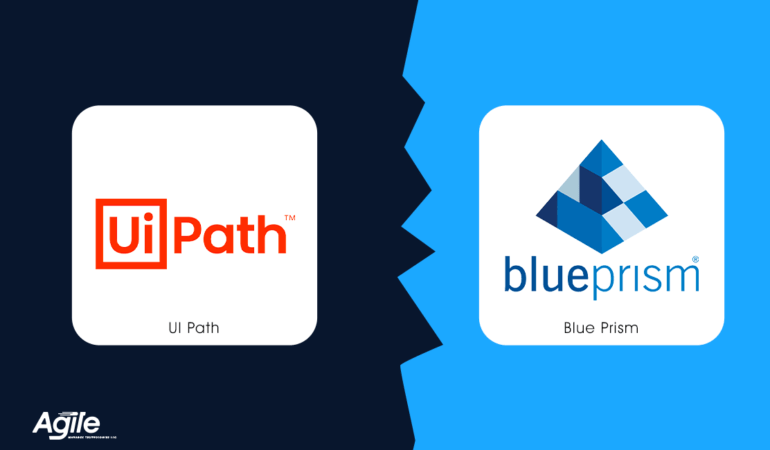Blue Prism or UiPath? Choosing the Best RPA Tool for Automation

RPA, or Robotic Process Automation, is more than just a buzzword in today’s tech-driven business landscape. It’s a transformative approach that automates mundane and repetitive tasks, freeing up employees to focus on more strategic initiatives. Robotic Process Automation (RPA) has emerged as a transformative technology for businesses seeking to streamline operations, enhance efficiency, and reduce human errors. But how do you pick the right RPA tool for your needs? That’s the golden question!
Among the numerous RPA tools available, two major players stand out: Blue Prism and UiPath.
Understanding Blue Prism and UiPath
Blue Prism is a pioneering RPA tool known for its robust capabilities in automating complex business processes. Its digital workforce offers scalability and precision in executing tasks across various industries. With Blue Prism, you can automate routine tasks, allowing your human employees to focus on higher-value activities.
UiPath is another leading RPA solution that empowers businesses to automate mundane tasks, enabling a more efficient workflow. Its user-friendly interface and extensive library of automation activities make it accessible to both technical and non-technical users. UiPath’s automation capabilities extend to a wide range of industries, promising increased productivity and reduced error rates.
Blue Prism: An Overview
So, what’s the lowdown on Blue Prism?
Core features:
Blue Prism is often seen as the pioneer in RPA. It provides a robust platform for automating complex business processes. Its drag-and-drop functionality, visual design, and adherence to IT governance make it a favorite among large enterprises.
Strengths:
Blue Prism’s cloud-based infrastructure ensures scalability, and its multi-environment deployment option is top-notch. Security is paramount, with features like role-based access and encryption in play.
Limitations:
However, it’s not all sunshine and rainbows. Blue Prism’s steep learning curve can be intimidating for beginners. Moreover, its licensing costs can be on the higher side for SMEs.
UiPath: An Overview
On the other side of the ring, we have UiPath.
Core features:
UiPath boasts a user-friendly interface, making it suitable even for those without a programming background. Its advanced screen scraping solution, compatibility with various applications, and extensive activity library make it a versatile tool.
Strengths:
With an open platform that’s easily integrated with other systems, UiPath is the go-to for businesses looking for flexibility. Its community edition, extensive training resources, and active forum are like cherries on the cake!
Limitations:
While it’s hard to pinpoint many weaknesses, some users feel that UiPath’s extensive features make it a tad overwhelming at times.
Use Cases for Blue Prism and UiPath
Blue Prism finds applications in various industries, including finance, healthcare, and manufacturing. For instance, in the finance sector, Blue Prism can automate credit card processing and fraud detection, reducing manual effort and improving accuracy.
UiPath’s versatility shines in industries like customer service, where it can automate ticketing systems and response management. This leads to faster query resolution and improved customer satisfaction.
Comparative Analysis: Blue Prism vs. UiPath
When Blue Prism and UiPath go head-to-head, who emerges as the victor?
Ease of use:
UiPath, with its intuitive interface, slightly edges out Blue Prism here. Newbies might find it a bit more welcoming. UiPath is user-friendly with its drag-and-drop interface. Blue Prism requires a steeper learning curve but compensates with advanced functionalities.
Scalability:
Both tools excel in scalability, but Blue Prism’s cloud infrastructure might appeal to larger organizations and ensures scalability. UiPath caters to both small and large businesses, allowing flexibility in scaling automation efforts.
Integration capabilities:
UiPath shines with its vast integrations, but Blue Prism isn’t far behind. UiPath offers pre-built connectors and APIs that facilitate the connection between different software and platforms.
Pricing:
UiPath offers a more competitive pricing structure, especially with its free community edition. It accommodates businesses of various sizes. Blue Prism tends to be more expensive upfront. Which makes it ideal for enterprises with substantial budgets.
Community and support:
UiPath takes the cake with its vibrant community, but Blue Prism’s dedicated support for enterprise clients is commendable. UiPath’s extensive community support provides a wealth of resources and solutions. Blue Prism offers robust professional support for enterprises with specific needs.
Security:
Blue Prism prioritizes security but UiPath is equally committed to security. Blue Prism has features like role-based access control and encryption. Which ensures that sensitive data and processes remain protected throughout the automation journey. UiPath has features that contribute to a secure automation environment.
How to Decide Between Blue Prism & UiPath?
But wait! Before jumping to conclusions, let’s consider a few more points.
Complexity of Processes
For highly complex processes, Blue Prism’s advanced capabilities are a better fit. UiPath works well for less intricate workflows.
Budget
Budget constraints might steer smaller businesses toward UiPath due to its flexible pricing.
IT Infrastructure
If your IT infrastructure is well-prepared for RPA integration, Blue Prism’s robustness can be fully leveraged.
Long-Term Strategy
Consider your organization’s long-term automation strategy. Blue Prism’s scalability might align with extensive automation roadmaps.
| Feature | Blue Prism | UiPath |
|---|---|---|
| Ease of Use | Moderate learning curve | Intuitive drag-and-drop interface |
| Scalability | Well-suited for large enterprises | Flexible scalability for businesses of all sizes |
| Integration | Powerful capabilities, requires tech proficiency | Broad integration options, user-friendly |
| Community Support | Professional support for specific needs | Extensive community, wide range of resources |
| Pricing | Higher upfront cost, suited for big budgets | Flexible pricing suitable for various budgets |
Conclusion
Both Blue Prism and UiPath are giants in the RPA arena. In the debate of Blue Prism vs. UiPath, there’s no one-size-fits-all answer. Each has its strengths and limitations. Blue Prism excels in complex and centralized processes, while UiPath offers agility and accessibility. However, the decision boils down to your specific business needs, goals, security considerations, scalability needs, and technical expertise. After all, the best tool is the one that fits snugly in your business toolbox, right?
FAQs
1. Which is more user-friendly, Blue Prism or UiPath?
UiPath generally has a more user-friendly interface, making it suitable for beginners.
2. Is Blue Prism more suitable for larger organizations?
While Blue Prism caters robustly to larger organizations, it doesn’t mean SMEs can’t benefit from it.
3. Does UiPath offer a free version?
Yes, UiPath offers a free community edition.
4. Which RPA tool has a more active community?
UiPath boasts a vibrant community, providing extensive support and resources.
5. Is the cost the only factor to consider when choosing an RPA tool?
No, while cost is vital, factors like scalability, support, ease of use, security, and integration capabilities are equally important.
6. Can RPA tools work with existing software?
Yes, both Blue Prism and UiPath offer integration capabilities that allow them to work with your existing systems and applications.
7. What industries can benefit from RPA?
Industries such as finance, healthcare, manufacturing, and customer service can benefit significantly from RPA implementation.
8. Is UiPath’s lower upfront cost indicative of lower quality?
Not necessarily. UiPath’s lower cost can make it an attractive option for small businesses, and it still offers powerful automation capabilities.
9. How do security features differ between Blue Prism and UiPath?
Both tools prioritize security. They offer features like access control, encryption, and data masking to protect sensitive information.
10. What’s the future outlook for RPA?
The future of RPA looks promising, with increased adoption across industries and the potential for even more advanced automation capabilities.
11. Can I switch from one RPA tool to another in the future?
Switching is possible but it can be complex due to the differences in architecture and features. It’s essential to carefully evaluate your options before making a switch.
12. Is training available for using these RPA tools?
Yes, both Blue Prism and UiPath offer training and resources to help users learn how to effectively use their platforms.

Leave A Comment